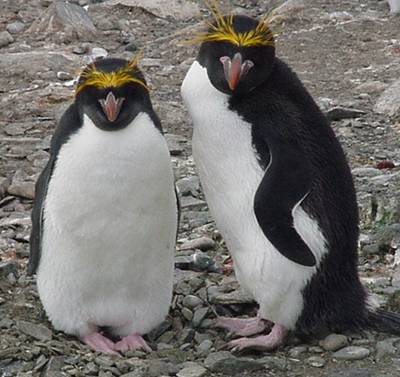


POPULATION TREND: Despite population estimates of more than 11 million birds, macaroni penguins have experienced an estimated decline of at least 30 percent. Macaroni penguins are also threatened by fisheries interactions and oil pollution. THREATS: Rising sea-surface temperatures as a result of global warming are expected to threaten the macaroni penguin's food supply by causing a decrease in prey abundance and driving prey further away from coastal areas and penguin breeding colonies. Standing up to 70 cm (about 28 inches) tall, royal penguins are among the tallest members of the genus Eudyptes. chrysolophus), and some ornithologists maintain that the royal penguin is a subspecies of the macaroni penguin. LIFE CYCLE: Macaroni penguins are thought to live between eight and 15 years in the wild.įEEDING: This penguin feeds mainly on krill, but will also eat other crustaceans, small fish, and squid. Royal penguins are often confused with macaroni penguins (E. Penguins leave their breeding colony by April or May. After hatching, chicks are guarded by the male and fed by the female for up to 25 days and then gather in small crèches until they are ready to go to sea at about 60 to 70 days old. Two eggs are laid in early November and are incubated by both parents in long shifts, hatching in 33 to 37 days. MIGRATION: Macaroni penguins are migratory and are rarely found near land during the non-breeding season.īREEDING: Macaroni penguins usually begin breeding in late October, assembling in huge colonies and nesting on level to steep ground in mud or gravel. While foraging, groups will range north to the islands off Australia, New Zealand, southern Brazil, Tristan da Cunha, and South Africa. They breed in at least 216 colonies at 50 sites, including southern Chile, the Falkland Islands, South Georgia and the South Sandwich islands, the South Orkney and South Shetland Islands, Bouvet Island, the Prince Edward and Marion islands, the Crozet Islands, the Kerguelen Islands, the Heard and McDonald Islands, and very locally on the Antarctic Peninsula. RANGE: Macaroni penguins range from the sub-Antarctic to the Antarctic Peninsula. HABITAT: Macaroni penguins live in rocky, water-bound areas, on rocks and cliffs above the ocean. This species closely resembles the royal penguin, but has a black chin rather than a white one. It has black upperparts, white underparts, and distinctive yellow and black plumes on the top of its head. Scientists are also uncertain whether rockhopper penguins are one, two, or three species.DESCRIPTION: The macaroni penguin averages about 20 to 28 inches in length and about 11 pounds in weight. It is still unclear if the royal penguin is a subspecies of the macaroni penguin. The white-flippered penguin is today generally considered a subspecies of the little penguin. There are 15-20 living species (types) of penguins. It doesn't matter to them, because they swallow the fish whole. A closer look at the DNA of penguins showed that all species lack functioning genes for the receptors of sweet, umami, and bitter tastes. This was discovered when a research team noticed they were missing some key genes for taste. They usually make nests on the ground with rocks or mud.

In most species the birds all nest together in a huge group, called a rookery. They don't eat there because they live in places where the land has no food for them. They come up on the land or ice to lay their eggs and raise the chicks. Penguins eat krill, fish, squid, and other small animals from the ocean, which they catch. If one parent does not return, the other must abandon the egg to go and eat. The time one parent is alone with the eggs or chicks and going hungry may be weeks or months depending on what kind of penguin they are. Parent penguins call to find each other amongst the thousands of birds when they return from the feeding grounds. The parent on baby duty has nothing to eat. The father and mother take turns keeping the eggs warm, and the chicks warm after hatching. After the penguins mate, the mother lays her egg or eggs and soon goes in the ocean to eat. Most penguins lay two eggs per year but emperor penguins lay only one. JBirds Macaroni Penguin The macaroni penguin is a species of penguin found throughout the southern Atlantic and Indian oceans. A penguin encounters a human during Antarctic summer.


 0 kommentar(er)
0 kommentar(er)
